The Apple Thunderbolt Display Review
by Anand Lal Shimpi on September 23, 2011 2:56 AM EST- Posted in
- Displays
- Mac
- Apple
- Thunderbolt
- Thunderbolt Display
Ever since I moved to a notebook as my main work computer I've become increasingly annoyed with the process of actually moving my notebook-as-a-desktop around. At my desk I've got DisplayPort, Ethernet, two USB, FireWire 800, speakers and power all plugged into a 15-inch MacBook Pro. What makes it frustrating isn't the first-world-problem of having to unplug seven cables, rather that it doesn't need to be seven cables - Apple could make the whole thing happen with just two.
Every Mac released in 2011 has at least one Thunderbolt port (the iMac has two), and Thunderbolt can deliver exactly what I'm looking for. Thunderbolt can carry two things: PCI Express and DisplayPort, the former for data and the latter obviously for video. Why would you want to carry PCIe and DP over a single cable? To address problems like the one above.
Pretty much all device expansion on modern day PCs happens via PCI Express. Several years ago it was hard to find PCIe sound cards or Ethernet controllers, but these days vanilla PCI slots are nearing extinction and PCIe is the de facto standard. Ethernet, USB and FireWire controllers all exist as single-lane PCIe devices. Put a bunch of them at the other end of a Thunderbolt cable and you no longer need to plug in a bunch of individual cables into your notebook when at your desk. Send DisplayPort over the same cable and you can actually move all of those ports onto your monitor, thereby using a single cable to carry everything but power to your display. And this is exactly what Apple has done with its new Thunderbolt Display. By mating its 27-inch LED Cinema Display with a bunch of integrated IO controllers, Apple is hoping to deliver a display that's more of a mobile docking station than just a passive way to display video.
Apple has tried this in the past. The old Cinema Displays used to feature an Apple Display Connector (ADC) that actually carried DVI, USB and power from a desktop Mac to the monitor. You only needed to plug in a single cable to your display, significantly reducing desktop clutter. Although Thunderbolt does carry power, it's limited to 10W - not enough to power any reasonably sized display. Where Thunderbolt does win out over ADC however is in its universal appeal. Intel created the standard. Although it's used almost exclusively on Apple systems today, come 2012 Intel is expecting PC OEMs to embrace the interface with its Cactus Ridge line of Thunderbolt controllers.
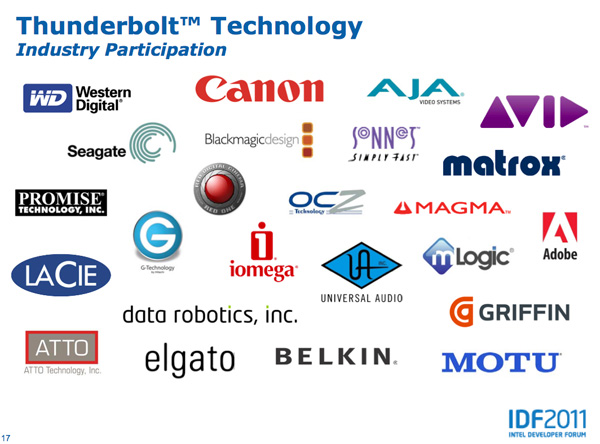
Apple's Thunderbolt Display
The Thunderbolt Display uses a near, if not perfectly, identical panel to what was in last year's 27-inch LED Cinema Display. You get a 27-inch, 16:9, 2560 x 1440 LED backlit display capable of at least 350 nits at full brightness. Apple seems to conservatively spec its desktop displays as we were able to measure 425 nits at max brightness. The uber brightness comes in handy because the display does have a glossy finish. Indoors it's not really a problem unless you're watching a dark movie scene with the display lit by a sun-facing window. Even then, cranking up the brightness all the way is usually enough to overcome any significant glare. As with all glossy displays, if you have light control (e.g. curtains or blinds) you'll be just fine.
The similarities don't end with the internal panel, the chassis is very similar to its older sibling and the Thunderbolt Display retails for the same $999 price.
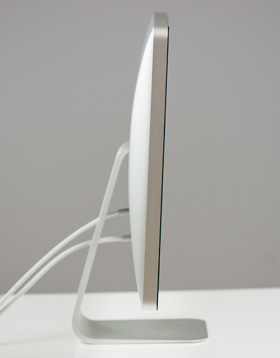 |
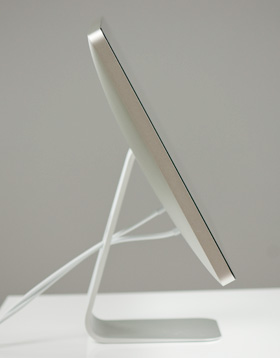 |
The display sits on an aluminum swivel base that allows for -5 degrees to 25 degrees of tilt along the horizontal axis. There's no height adjustment for the display either, only tilt. Personally, I use a height adjustable desk as I find it helps me avoid any carpal tunnel pain. Combined with a height adjustable chair, the lack of height adjustment on the display doesn't bother me. If you have a fixed height desk however, this may be a problem.
Aesthetically the Thunderbolt Display continues Apple's aluminum meets glass design language. The front of the display is all glass, while the edges and back are all aluminum. Along the top surface of the display is a mic for the integrated FaceTime HD camera. The outgoing 27-inch LED Cinema Display (still available for purchase online) sported a 640 x 480 camera, while the Thunderbolt Display ups capture resolution to 1280 x 720.
There's an ambient light sensor hidden in the top bezel of the display, but as always you can disable its functionality from within OS X.
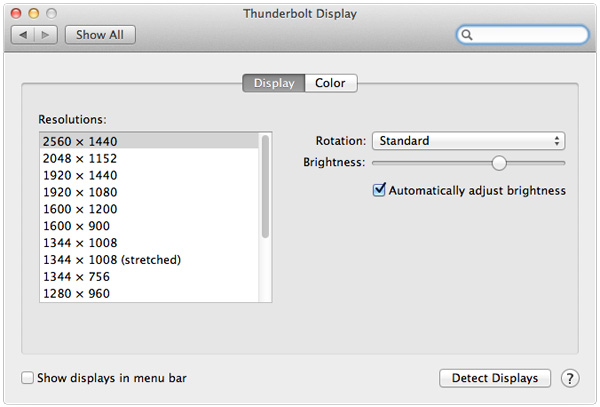
There are two integrated speakers in the display, again unchanged from the previous LED Cinema Display.
Two cables attach directly to the display: a removable power cable and an integrated IO cable. Cable management is done through a round cutout in the aluminum stand. The IO cable is where things really change with the Thunderbolt Display. Instead of a breakout of three cables as was the case with the Cinema Display, there are now only two: MagSafe and Thunderbolt.
The MagSafe connector remains unchanged. If you've got any Mac that can be charged by an 85W MagSafe adapter, the Thunderbolt Display will charge said Mac. This feature alone is particularly awesome for notebook-as-a-desktop users since it allows you to just keep your actual AC adapter tucked away in your travel bag. For me I keep my MagSafe adapter in my bag and never take it out so I never have to worry about forgetting to pack it. Given how expensive MagSafe adapters are ($79 for an 85W), this is a nice feature for MacBook Air/Pro owners.
The Thunderbolt cable is obviously what gives this new display its name. Inside the Thunderbolt Display is an Intel Light Ridge Thunderbolt controller. The type of controller is important as it bestows upon the display some clear limitations. The biggest of course is the lack of support for all non-Thunderbolt systems. That's right, the only way to get video to the Thunderbolt Display is by using a Thunderbolt enabled Mac (or theoretically a Thunderbolt enabled PC). For Mac users that means only 2011 MacBook Pro, Air, iMac or Mac mini models will work with the Thunderbolt Display. Everyone else has to either buy a new Mac or stick with older displays.
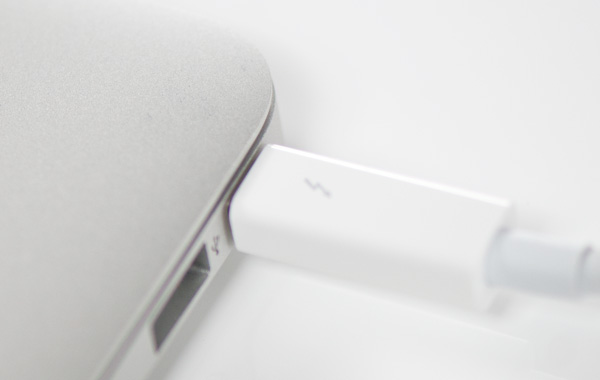
I believe the limitation here is actually on the cable side. A Thunderbolt cable can only transmit a Thunderbolt signal. Although DisplayPort is muxed in, if the display on the other end is expecting Thunderbolt and it receives DisplayPort it won't know what to do with it. It's possible Apple could have built in logic to autosense and switch between Thunderbolt and DisplayPort as inputs, but Apple traditionally employs clean breaks rather than long technology transitions. If Apple wants to ensure Thunderbolt gets adopted (at least by its users), this is the way to do it. As we learned from other legacy interfaces (e.g. PS/2, IDE), if you enable backwards compatibility you'll ensure the survival of systems that implement those interfaces. It's not so great for existing customers unfortunately.


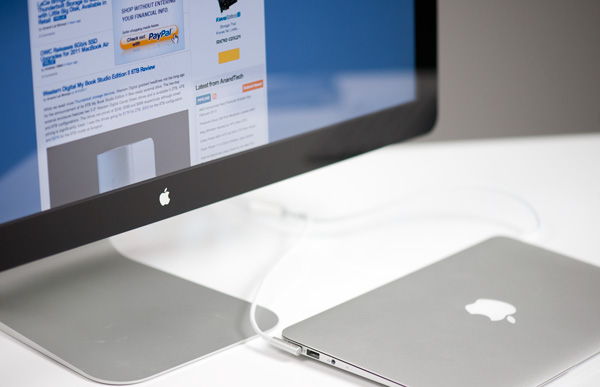
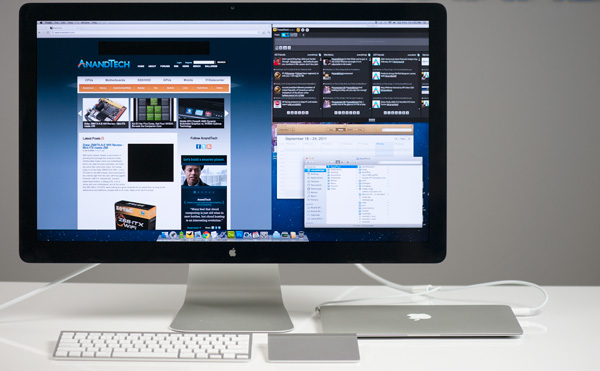
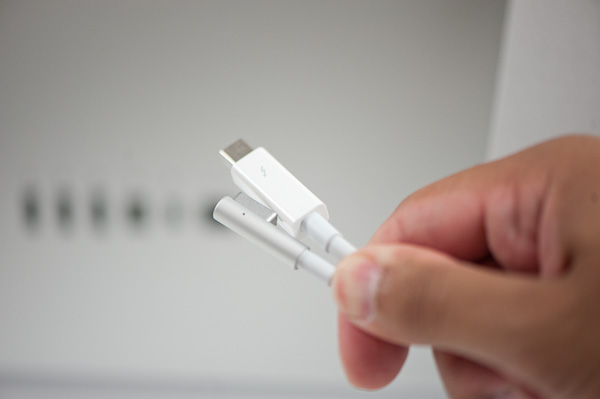








275 Comments
View All Comments
NCM - Friday, September 23, 2011 - link
At under a grand for a giant IPS display that incorporates at least $200 worth of extra connectivity (laptop power supply, T'bolt, additional ports, speakers) this monitor is good value for a MacBook Pro or Air user.Colour accuracy is more than adequate for most professional work. If it's not good enough you should be taking a big step up to something like an Eizo, both shrinking the display size and doubling the price in the process.
jecs - Friday, September 23, 2011 - link
You did read but you just don't understand what color accuracy means or what to do with it.What you call poor color accuracy is the gamut space that is important only if you work with wide gamut color. Apple does not cares for wide gamut, not with this display or with past displays. It does not means the display is not accurate in color, it is very accurate. But Apple optimize their displays for print accuracy were wide gamut is not required. Even for FCP Apple doesn't work with wide gamut. For consumer use wide gamut is also a mixed bag because many complain the color in general looks to bright or "artificial".
I have a 2410 Dell display because I care for wide gamut for what I do but I do appreciate Apple displays and this thunderbolt display is good and other vendors should pay attention to the connectivity and function for desktop use. I would want a mate screen version for more serious professional design but for demanding consumers who appreciate quality and efficiency this is a nice option.
But right now what you need to know is what display is best for what you do.
Are you a professional. Are you a consumer or an aficionado looking for an intermediate option. Or buying the cheapest display.
The Apple displays are for entry level professionals or high end consumers or hobbyist.
For broadcast professional work or for cheap options look else where.
hechacker1 - Friday, September 23, 2011 - link
While I agree with your overall point, I don't think the calibration used by Anand is really informative unless you are doing photo processing work.He's targeting the Adobe 1998 profile, which is great for photo editing and printers that support that target (rare unless in a professional setting).
Most of the Internet is SRGB profile by default, and I'm guessing this display would perform even better there. Most consumer cameras also target SRGB unless you are talking about RAW mode prosumer cameras.
The fact that this display can accurately display most of the Adobe profile bodes well for its accuracy.
If you were in Broadcasting or video editing, you should target Rec. 709 profile, which has completely different gamma curves.
In my opinion, Apple displays are generally very good for the money. Even my late 2009 Macbook Pro can calibrate to excellent color accuracy with VERY little error.
However, my biggest complaint is that lately Apple displays target 6800-6900K color temps, which are too blue for most calibrations and profiles. Sure it looks good to the untrained eye, but it's bad for color accuracy.
jecs - Friday, September 23, 2011 - link
I agree to your more expert opinion than mine.Apple is moving more than ever to the high end consumer or prosumer and the move to the higher kelvin could be another sign. Final Cut X and the price is another example.
But all in all Apple displays are still good monitors.
If you want a very cheap desktop IPS panel Dell also has a new Ultrasharp line with a shorter gamma space and fewer connectors. But there are other cheap options.
Ratman6161 - Friday, September 23, 2011 - link
...that I would not be in the market for a $1000+ display from Apple, Dell or an other manufacturer. What i'm in the market for is the best I can get for $200 - $300. Now, what I can get for my dell is a docking station that comes with an additional power brick for $129.00. So I can get a decent (not great but decent) 22 to 24 inch display + a docking station well within my budget.I guess if a 27" is what you absolutely have to have and you are willing to pay for it, this is a good option...but not for me.
NCM - Friday, September 23, 2011 - link
Which is fine and all, but the fact that you aren't in the market for a monitor in this category is completely irrelevant to the discussion.What's next, that we start posting about our cats?
BrooksT - Saturday, September 24, 2011 - link
Why would you spend $200 on a monitor when you can get a legal pad and pen for $8? I guess if you have to have a computer monitor and you're willing to pay for it, but paper and pen are better options for many people.name99 - Friday, September 23, 2011 - link
Professionals pay for quality tools.Look, if you're earning $100K a year, and this makes you more productive (not to mention happier) it's worth it.
Are you amazed that professional carpenters don't use $5 saws from Target? That professional truckers rig up the insides of their rigs with fancy electronics? That professional musicians buy high quality instruments, not what they can find on Craigslist?
seapeople - Friday, September 23, 2011 - link
You can also buy a $60,000 Cadillac Escalade SUV to pick up your kids at soccer practice.What's your point again?
alphaod - Friday, September 23, 2011 - link
Nice review as usual; very tempted to purchase one, but I think I'm fine with my current setup; already have a power supply I keep plugged in at times.Honestly if Apple added a powerful GPU, yes I think it would a more enticing purchase, but than they'd have the issue of cooling this unit, powering this unit, and constantly upgrade GPUs; at the same time, we'd have people posting online asking all day when the next Thunderbolt GPU updates will come. This would probably also cause problems with pricing; it would come awfully close to the price of an iMac which I'm sure most people would then consider buying an iMac instead (making this product redundant).
Personally I'd prefer if Apple added an optical drive (for those of us who replaced the optical drives in our MacBook Pro notebooks), optical out, better GPU in the display~Hell forget about releasing this display; redo the iMac as a dock for the MacBook Air/Pro!